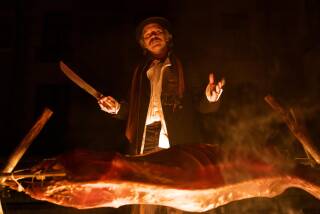Epidemics of Fear and Mistrust
- Share via
We ought not be surprised when governments or opinion makers downplay or distort perceived epidemiological hazards, as China did with the initial outbreak of severe acute respiratory syndrome.
Eighty years ago, it happened in our own backyard.
The last major outbreak of the plague in the United States was in Los Angeles in the fall of 1924. Public health physicians began to piece together disturbing information about a number of deaths in the Macy Street district, a downtown neighborhood near where the Twin Towers jail complex now stands.
Most of the members of one family and nearly all their close kin died suddenly. Then an ambulance driver who transported the sick got sick. So did a priest summoned from Our Lady of the Angels to administer last rites to a dying man. Both the driver and the priest died.
Doctors initially suspected meningitis, influenza, even typhus. But microscopic study revealed something else entirely: the unmistakable Bacillus pestis, bubonic plague.
Public health officials acted quickly. Under standard procedures of the day, the entire neighborhood was quarantined by force. The Fire Department roped off streets with fire hoses, and police officers along with deputized veterans of World War I patrolled quarantine boundaries. As the plague was understood to be spread by vermin, health department workers began an aggressive rat-killing campaign.
At the county hospital, suspected plague patients, their toes tagged with ominous red cards, underwent treatment. Doctors uncertain of what to do alternately stimulated them with caffeine, digitalis, adrenalin and pituitrin and brought them down with morphine, codeine, quinine and atrophine. Patients were injected with alcohol, mercurochrome, calcium lactate and saline. Plague serum existed in 1924, but there was none in Los Angeles, and by the time it was brought in from the East Coast it was too late to be of much use.
Quarantine undoubtedly helped make the plague outbreak less than a full-fledged epidemic. When it was all over, fewer than 40 people had died.
But quarantine alone does not tell the full story, and it is important that we remember more about the event than this.
Health-care and charity workers bravely went about their work ministering to the frightened, the sick and the dying. From downtown offices, however, opinion makers and public officials “spun” news of bubonic plague in sinister ways.
Some reached for ugly explanations that equated disease with ethnicity. Because most victims were of Mexican descent, the disease must have some essential “Mexican-ness” to it. How else to explain the quarantine of several “Mexican” apartment houses and “Mexican” homes with no connection to the disease vector?
Managers of downtown hotels and restaurants fired hundreds of Latino workers when they showed up for work. Outraged officials from Mexico pointed out that the workers must not have lived in quarantined neighborhoods if they could get to work in the first place. Most got their jobs back.
Seizing on the epidemic as an opportunity to perform radical urban renewal in low-income neighborhoods, health officials, backed up by commercial and government leaders, destroyed countless houses, shacks and outbuildings deemed menaces to public health. Because the actions were performed under emergency measures, no compensation was granted to owners, and no housing provisions were made for several thousand displaced occupants.
As did their modern-day counterparts in China, civic officials downplayed the significance of the epidemic. One man who would grow up to be a Los Angeles physician remembers the 1924 plague outbreak as a “big hush-up.” Even his father, who ran a factory within walking distance of Macy Street, knew little of the outbreak.
The Chamber of Commerce worked overtime insisting that Los Angeles was the picture of urban health, even to the point of printing special postcards to that effect.
Newspapers helped out. The manager of the Los Angeles Examiner vowed to print news only “in the interest of the city.” Other papers, including the Los Angeles Times, went along. Only Spanish-language papers like El Heraldo de Mexico dared call attention to the “hermetic silence in which authorities have locked themselves.”
In this time of SARS, we can learn something from the 1924 experience. The Los Angeles plague did not become a Black Death, the plague that killed millions in Europe in the 14th century. But like any social crisis, it did reveal the best and worst instincts of people and institutions battling contagion and fear. Historians study such moments precisely because they tell us about deep social realities and dynamics.
Governments abet disease when they keep secrets and peddle disinformation. Public health can be maintained only when people insist that their leaders be as vigilant about truth as they are about hygiene.






